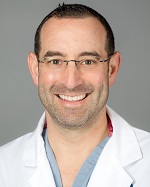Eye-Opening Facts about Ocular Melanoma
Most people had never heard of ocular melanoma until alarming news reports about this rare eye cancer being diagnosed in four friends who graduated from Auburn University, as well as 18 patients in Huntersville, NC.
The news has baffled experts in part because the odds of developing ocular melanoma are about six in a million people per year – much rarer than melanomas of the skin. About 2,000 Americans are diagnosed each year.

Dr. Jonathan Zager is investigating a chemosaturation procedure to treat ocular melanoma patients with liver metastasis.
The idea that four college friends or 18 citizens of a North Carolina town all developed this rare eye cancer “is so strange, it has to be more than coincidence,” said Dr. Jonathan Zager, professor of surgery, senior member and director of Regional Therapies in Cutaneous Oncology and Sarcoma at Moffitt Cancer Center.
In its early stages, OM may not cause any symptoms and, since it usually develops in a part of the eye you can’t see, you may not realize anything is wrong. But in about half the patients, the cancer spreads – most often to the liver – and becomes life-threatening.
That is where much of Moffitt’s clinical research efforts have been focused. As a surgical oncologist, Zager has treated dozens of OM patients with metastatic disease.
“It’s impossible at this juncture to tell what causes this, though we suspect a particular type of genetic mutation and possibly a small link to sun exposure.”
Dr. Zager currently heads up an international clinical trial at some 40 locations worldwide to address liver tumors that develop when OM spreads. The FOCUS trial involves a surgical procedure called PHP, for percutaneous hepatic perfusion.
PHP isolates blood flow to and from the liver, allowing for high-dose heated chemotherapy to be administered directly to the liver through a catheter. The chemotherapy-laden blood is filtered outside the body and returned to the patient via a separate catheter. Zager said the procedure has been very effective in treating liver tumors in previous trials.
Like skin melanomas, OM starts in pigment cells called melanocytes that give color to the eyes. Unlike skin melanoma, which is closely linked to UV light exposure from the sun or tanning beds, there is no certainty about what causes OM.
And surprisingly, those who’ve had a skin melanoma are not at higher risk for developing OM. Once diagnosed with OM, patients are most frequently treated with lasers, radiation or by removing the eye. Current immunotherapy drugs making headlines for progress against skin melanomas are far less effective for metastatic OM.
So is there any way to protect against OM? Dr. Zeynep Eroglu, medical oncologist in Moffitt’s Department of Cutaneous Oncology, noted that most of OM’s known risk factors are beyond our control. “While this is a very rare tumor overall, it is more common in patients with certain hereditary genetic abnormalities, or those with fair skin and blue eyes,” said Dr. Eroglu.
Limiting sun or UV exposure in this population is already wise for skin melanoma prevention, and use of UV-protective sunglasses can’t hurt for ocular melanoma as well. She also advises:
- Those with abnormalities in their eyes, like moles or hyperpigmentation, should be followed by an ophthalmologist.
- Your physician should be aware of any family history of OM or inherited skin conditions like dysplastic nevus syndrome (abnormal moles).
- Changes such as a visible dark spot on the eye, the shape of the pupil, pain in one eye, blurred or distorted vision or the sensation of flashing lights – all possible symptoms of OM - warrant a talk with your eye doctor.
“Any time the incidence of a rare cancer increases in a given geographic area, environmental factors start to be considered,” added Eroglu. She recommended following news coverage to see if any type of environmental exposure can be identified.


